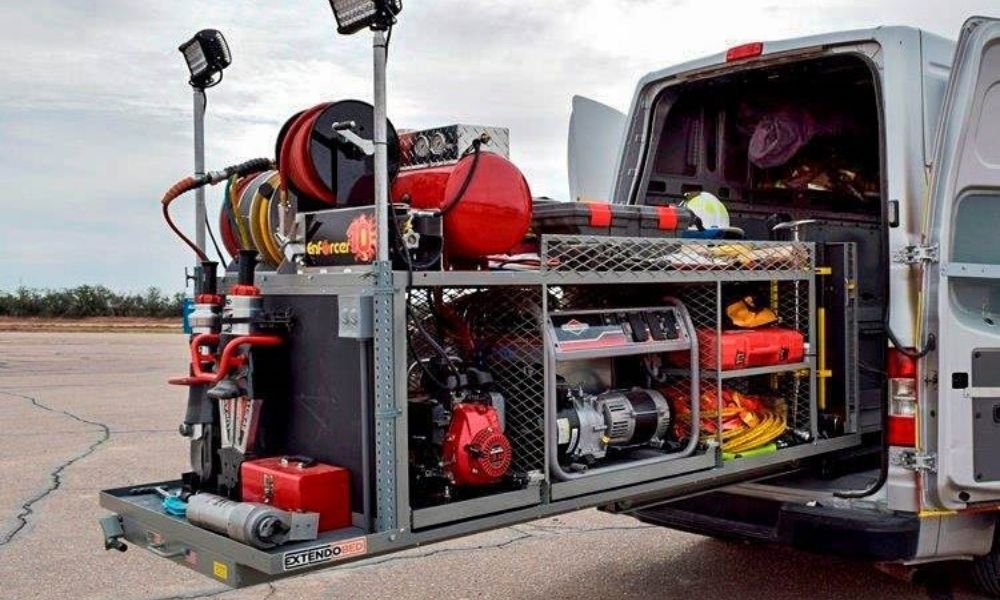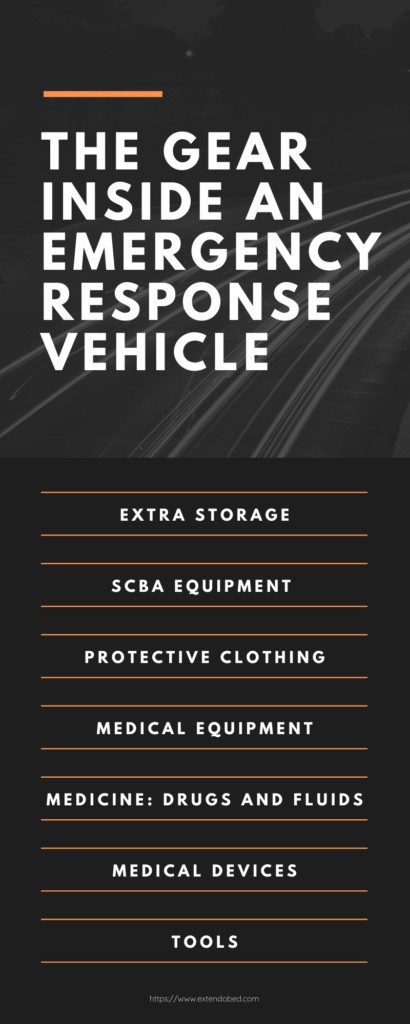Menu

Three major emergency response vehicle types are typically used across America: police vehicles, fire apparatus, and medical response vehicles. Although they carry similar supplies, there’s a lot of unique gear each type of vehicle must carry. Here’s a basic list of the gear inside an emergency response vehicle, minus the gear you’ll need for police vehicles, as we covered that topic recently.
Although response vehicles specialize in dealing with certain situations, there are plenty of tools they use across the board. Here’s a short list describing the typical gear response vehicles need.
These are the major pieces of gear that every response vehicle should always carry. This gear and the specialized equipment each type of vehicle brings along helps responders address any emergencies they might encounter.
You might notice this is already a lot of gear, and it doesn’t even include the specialty equipment each responder type will need. Storing all the gear inside an emergency response vehicle, and then being able to quickly retrieve it, isn’t easy—in fact, it’s almost impossible without the aid of additional storage solutions. That’s why many response vehicles use aftermarket modifications, like the firefighter’s pull-out truck bed storage. This helps responders carry and quickly unload their gear with less risk to themselves.
Fire apparatus are constantly mobilizing for various emergencies, arriving at the tamest to the most dangerous situations. They must carry a huge variety of gear for the different situations to which they respond. However, their main focus is fire suppression, which requires a lot of equipment that other vehicles don’t need. As the main job of a fire apparatus is controlling the spread of fires that may occur at any location, most of the equipment is for dealing with fires. From protective gear that helps firefighters approach a dangerous situation to the gear that helps suppress the fire, each fire apparatus carries it all wherever people need it. Here’s a deeper look into the tools and gear that fire apparatus carry.
The main equipment a fire apparatus carries is its tools for fire suppression: the hose and nozzles that shoot water and chemical fire suppressants. This can take up a lot of space in a vehicle and is why so many fire apparatus are so large. They carry tanks full of water and chemicals, plus the equipment for pumping it through the hoses.
Another piece of gear that’s vital for a fire apparatus is the SCBA or self-contained breathing apparatus equipment. This gear helps professionals see and breathe in places with heavy smoke and fire, making it a vital part of any firefighter’s gear.
Just as the SCBA equipment helps with breathing near fire and smoke, protective clothing is necessary for firefighters in the same situations. These layers of clothing help protect firefighters from the heat and offer some padding, so having it readily available is important for success. In addition, many departments are requiring separate and sealed storage of protective clothing after an incident since there may have been toxic chemicals involved. This requires storage space as well.
There are dozens of other individual items that are useful for firefighters, so many vehicles carry them. Radios, hand lights, axes, ropes, and roof hooks are all items that every fire apparatus carries, and firefighters often use these in emergencies.
Medical response vehicles are full of specialized gear with the sole purpose of saving lives, which is why they maximize their space utilization with medical devices and equipment. For a better understanding of what goes into a medical response vehicle, here’s a brief look at the gear you might find in an ambulance.
Each ambulance carries the equipment that best preserves life while on the move. Things like bandages and splints are very common equipment you’ll find in a medical response vehicle.
Similarly, a lot of medical emergencies require medical drugs for stabilization and treatment. Things like sedatives and EpiPens are very common in ambulances, with whole cabinets dedicated to carrying emergency medicine. They also frequently carry intravenous fluids so people can get the liquids they need during transportation.
Another category of gear ambulances carry includes medical devices that measure vitals and help stabilize people. This includes cardiac monitors, oxygen masks, and oxygen, which help professionals keep people alive during transport to the hospital.
Medical emergency response vehicles also need an array of tools many other response vehicles may or may not carry. Things like blankets, needles and scissors are vital tools for a response vehicle. Stretchers for carrying patients by foot may also be needed.
This list is only the general categories of items and equipment that you’ll find inside an emergency response vehicle. Each type of vehicle requires vastly different gear for different jobs, which is why the layout and size of each type of emergency response vehicle are so different. However, getting all the gear inside, and then being able to quickly access it and store it again is possible with proper planning, knowledge, and good storage solutions.

Copyright © 2024 Extendobed®